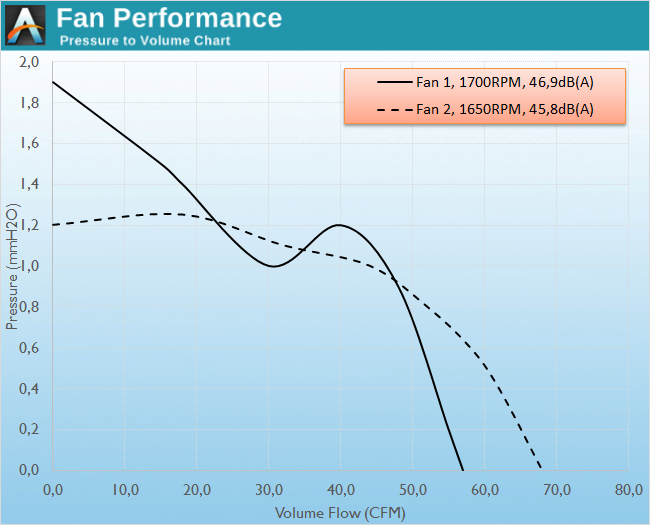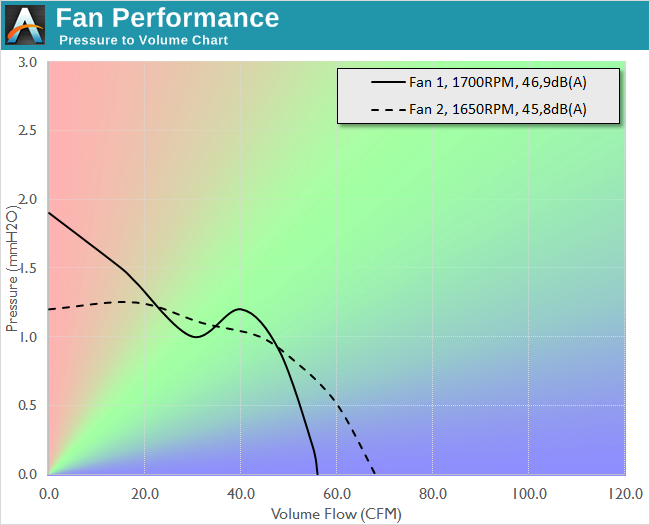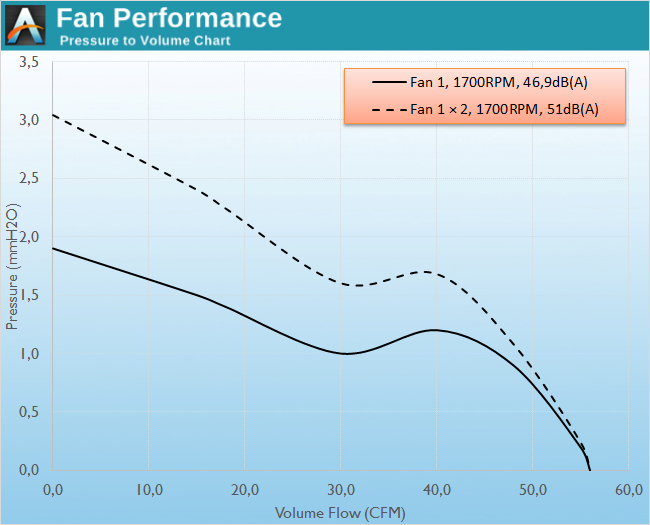The Corsair SP (Static Pressure), AF (High Airflow) 120/140mm Fan Review
by E. Fylladitakis on November 25, 2015 8:00 AM ESTFan Testing Methodology
For our first fan review we want to talk about the performance of fans and discuss how we will be testing them in our upcoming articles. This will serve as both a reference point for readers and manufacturers, as well as a chance to receive feedback and input on what we're doing before our first roundups start coming out. A large percentage of computer users are unconcerned with the actual performance of any given fan; most base their choices on recommendations and are swayed by marketing claims of "noiseless operation" and "astounding performance". Advanced users and enthusiasts are using up a lot of grey matter on the topic, seeking to find the best possible solution over dozens of possible choices. Regrettably, even if the user possesses the will and the knowledge to select a product suitable for his/her needs, they are often limited to the manufacturer's specifications, which usually are vague at best.
The fan manufacturers typically provide only a few performance figures, such as the static pressure and maximum volume flow ratings of a fan. However, even if these figures are 100% accurate (and they frequently are not), they are entirely useless to the end consumer. There are many who believe that a high static pressure rating is good for coolers and a high volume flow rating is good for case fans, but this is far from accurate. Maximum static pressure is taken at zero volume flow and maximum volume flow means zero static pressure; either scenario is impossible under real-world conditions. Furthermore, the maximum volume flow is usually calculated from the maximum velocity recorded at the exit of the fan. This is also entirely unrealistic as the fluid flow will definitely not be even across the entire exit area of the fan. The result is that retail products tend to have actual volume flows significantly lower than their specified maximum CFM ratings.
To measure the actual performance of a fan, the user has to know the P-Q (pressure to volume) chart of the fan. Here we measure the amount of applied pressure restriction, measured in mmH2O (where 1 mm H2O is the equivalent of 9.81 Pascals - one Pascal is the pressure required to accelerate 1 kg of mass at a speed of 1 meters per second squared per square meter) required to give a specific volume flow (measured in cubic feet per minute or CFM). The more the flow is restricted, the less volume flow is generated and the higher the pressure of the fan is. Still, some of the computer users who actually know how to interpret a P-Q chart are frequently misconceived that a P-Q chart is depicted by a straight line, such as this:
This is the misconception about pressure to volume - reality is a non-linear response
Unfortunately, this could not be further from the truth. The shape of the curve varies between the maximum static pressure and maximum volume flow rating, depending on several dozens of factors, mainly having to do with the design of the blades and the torque (the pushing power) of the engine. As such, two near-identical fans can have completely different behavior, which can be muddied by the actual 'naming' of the fan as an added element of confusion.
For example, the following chart depicts the P-Q chart of two fans. The first fan has a higher static pressure rating than the second and they both have an equal maximum volume flow (on paper), yet the second fan is a better selection for use as a case fan as it performs better when there are few obstructions.
Fan 2 is preferred in low impedance scenarios (low mmH2O)
as it gives higher airflow (>60 CFM under 0.6 mmH2O)
Unfortunately, the calculation of the impedance (resistance to move air) the fan will face by a grill/cooler/radiator/filter can be very difficult to assess without specialized equipment. It can be measured but it depends on far too many variables, including several environmental figures, such as the temperature and the air density. Even if we did extract a specific graph for every single part, the actual graph would be different for every single user. Therefore, it is not practical to give a graph depicting the exact impedance that an item has. It is however possible to provide an usable estimate, which we will be doing so in our future cooler and radiator reviews. The impedance of different items that can restrict the airflow looks like this:
Where the impedance line intersects with the fan's performance curve, that's where the fan will operate.
So a low impedance item generates 0.3 mm H2O of pressure and hits the fan curve at ~63 CFM in this case.
The green line depicts a high impedance item, such as a very dense liquid cooling radiator. The purple line is for a medium impedance item, such as a cooler. The black line is for a low impedance application, such as a case fan with a simple finger guard or a clean filter. For example, the medium impedance item in the graph above would have the fan moving about 32 CFM. There are no actual conditions under which the actual performance of a fan will go very near its maximum static pressure point nor will a fan will reach its maximum volume flow. This allows us to provide a usable estimate when testing coolers, radiators and similar devices. For example, a "very high impedance" radiator would lean towards the left side of the red area, while a "medium to low impendance" cooler would lean towards the right side of the green area.
Where the impedance line intersects with the fan's performance curve, that is the aiflow impedance pressure drop, or by how much of a pressure drop the device (cooler, radiator, filter, etc.) will cause to a fan. Note that the impedance line is highly unlikely to intersect at the same airflow impedance pressure drop point for different fan performance curves. As such, the pressure drop is not something that can be universally assessed for each application but depends on the fan itself as well.
We will be using the above style of graph for the delivery of our results, maintaining the same axes for 120mm/140mm fans for easy comparisons. The red, green and blue areas should be consulted for high, medium and low impedance applications respectively. Even if the axes do shorten, note that the areas remain nearly identical if the range of both axes is reduced by the same percentage.
When the expected obstruction is high, some manufacturers use two fans in series (a push-pull configuration). This is often the case with liquid-cooling radiators. When two fans are placed in series, their pressure at a given airflow is increased (but not doubled) and thus the airflow at a given pressure point is increased, as seen in the following example.
Using two fans in a push/pull configuration.
Thus at a static pressure of 1.5 mmH2O (medium impedance device, such as an air cooler), volume flow increases here from 15 CFM to 43 CFM. However, their maximum airflow will always be the same; therefore, this approach makes no sense when the impedance is low and only in high static pressure situations.
How AnandTech Will Test Fans
We will begin testing fans using an Extech HD350 differential manometer with a Pitot tube, an Extech AN200 velocity meter, and a custom apparatus designed for this specific purpose. The apparatus has a mechanism that allows us to test the unobstructed (maximum) volume flow of a fan, the fully obstructed (maximum static) pressure of the fan, and multiple points in between, allowing us to compose the actual P-Q performance chart of any fan. However, we are measuring the actual airflow generated by the fan, not that calculated by our maximum recorded air velocity.
For noise measurements, we are using an Extech HD600 high sensitivity SPL meter. The noise of the fan is measured from 15 centimeters away, not one meter as IEC certifications require, as that would be far too great a distance to measure differences between nearly silent products. Note however that we are measuring the noise level of a fan with its flow unobstructed. The addition of far grills, the installation on a cooler, and any other form of obstruction will increase the generated noise, as aerodynamic noise will be added into the environment.
We also plan on testing fans at their "stock" 12 V PC voltage and at a lower voltage, which will most usually be 7 V. This may not always be practical on some fans (i.e. very low speed fans may have their performance degraded far too much), but when it is we will do so. While it's impossible to state how any fan will perform in every situation, we will be able to provide at least a more rigorous view of each fan's performance. In the meantime, any feedback on our approach to testing or requests for additional tests is welcome.















92 Comments
View All Comments
Ian Cutress - Wednesday, November 25, 2015 - link
Sorry, that was my bad. I edited a few things and got mixed up. The definition now reads 'one Pascal is the pressure required to accelerate 1 kg of mass at a speed of 1 meters per second squared per square meter'. Admittedly it's a bit clunky, but it's the best way (from my perspective) to visualize it.nutral - Thursday, November 26, 2015 - link
It kind of says that 1 pascal is still the pressure required to accelerate 1 kg of mass over an area, i would just keep it at 1 pascal is equal to 1 newton per square meter. the gravity acting on 1 kg is 9,81 newton.Arbie - Wednesday, November 25, 2015 - link
If you're starting on fans, check out the old X-Bit Labs site. They had very thorough reviews which helped a lot in balancing noise vs cooling performance for different applications. Here's a link to that section:http://www.xbitlabs.com/articles/coolers/
They haven't published in a year, but fortunately the material is still available. Sad to see them quit...
sheh - Wednesday, November 25, 2015 - link
Thanks for the interesting review.It might help if there was a way to summarize the results in a more condensed manner. I don't have an ideal solution, but perhaps overlay more results in a single graph.
It would help if the voltage was specified in the graphs, and not only the RPM.
Some basic details are missing on the fans: startup voltage, "cruise" voltage, official specs (would be interesting to see even if somewhat arbitrary).
It would be nice to see more detailed noise-vs-RPM/voltage figures.
BTW, parts of some of the graph images are blurry. Anandtech's become much less consistent in the visual looks of graphs, and with occasional hiccups in quality. Also the frequent low quality JPEGs in the homepage make it less polished than it used to be.
britjh22 - Wednesday, November 25, 2015 - link
Great technical analysis as always on this site. I'd just recommend one addition, a real world test. It would be very interesting to take a standardized test bench, let's say an overclocked i7, and have a 240mm AIO solution and an air cooler. It would be great to be able to see the actual effect on the temps by just changing fans, and would give a great data point for user value analysis. Being able to see how a fan statistically performs is great, but the real world effect vs. cost is what I would LOVE to see.lorribot - Wednesday, November 25, 2015 - link
Whilst i love all the technical stuff all the graphs don't really help me decide which fans i should be buying for my case and radiator. What I need is some specifics such as fan a will need to run at x000 rpm to cool a 200w processor to 60C and produce xdb at that point. That would be a repeatable real world test that had some meaning. For case fans you need some form of test for rpm and db for each fan to provide a specific airflow that would be need for something like the above load plus a Graphics card.A separate article on the differences a case design can make to noise and fan performance would be good, especially the difference a grill would have over a perforated sheet metal.
Oxford Guy - Thursday, November 26, 2015 - link
"all the graphs don't really help me decide which fans i should be buying for my case and radiator"What you meant to say is that it doesn't tell you everything you want to know to make informed choices.
Oxford Guy - Thursday, November 26, 2015 - link
One thing that most people don't take into account are the frequencies emitted from fans. I know it's a lot to ask but it could be nice to see the spectrum for fans that are tested. Typically, more decibels in lower frequencies is more pleasant, and less likely to aggravate tinnitus, than more in shriller ones.nutral - Thursday, November 26, 2015 - link
The graphs are a bit confusing, especially with the colours. And did there have to be so many? Impedance in this case is not the correct term, because that applies to the impedance it has to changing air flow, in this case it is resistance. (like in electricity, resistance vs impedance, where impedance is used for AC)I would really rather use Pascal instead of mmH2O and m3/h instead of cfm but i guess that is your choice, having 1 imperial and 1 metric measurement is a bit strange though. 1mmH2O or 9,81 pascal is equal to about 1 meter of air column head. The left legend also should say static pressure instead of just pressure, because the pressure is a compination of static and velocity.
The graphs are called Pressure/flow, using volume is the incorrect term, as it is not talking about the volume but the actual displacement of air.
I was thinking of making a test setup myself for testing fans and their pressure/flow curves. How did you setup your apperatus to restrict air flow and test at different static pressures?
It would be really nice to have a simple module on the website, that puts the graphs of fans and graphs of different components like radiators and cpu coolers over each other to see what the best performance would be.
kalboston - Thursday, November 26, 2015 - link
All in all, an excellent article with very informative information. I am also not use to seeing performance/fan curves presented this way but I am able to understand what the author was trying to convey.Typically in the US, airflow is measured by CFM (Cubic Feet Minute) and In H2O (Inches Of Water Column/Gauge) or M/S (Cubic Meters per Second) and Pascals.
I do agree mixing imperial and SI units is not typical, but there are plenty of applications in the real world that this is done.
I do believe the author tried to perform a controlled test based upon his other articles and methodology. Without knowing the test setup and techniques used, there is always questions that could potentially affect the results. I for one would not have used a pitot tube, most likely a thermal anemometer. A very accurate test setup for airflow is a lot of money for a tech review site that would most likely never recoup the cost.
End result was a great amount of time by the author testing multiple units with many potential variables and presenting the data in a way that they felt was appropriate. For that I am greatly appreciative of, it was an excellently presented piece taking their perspective into account.
I have no college education, although I do have almost 10 years of Biotech and Semi Conductor Cleanroom Certification and Balancing.
I also learned something a long time ago about engineers summed up to a saying I saw "Arguing with an engineer is like wrestling a pig, after awhile your realize they enjoy it"